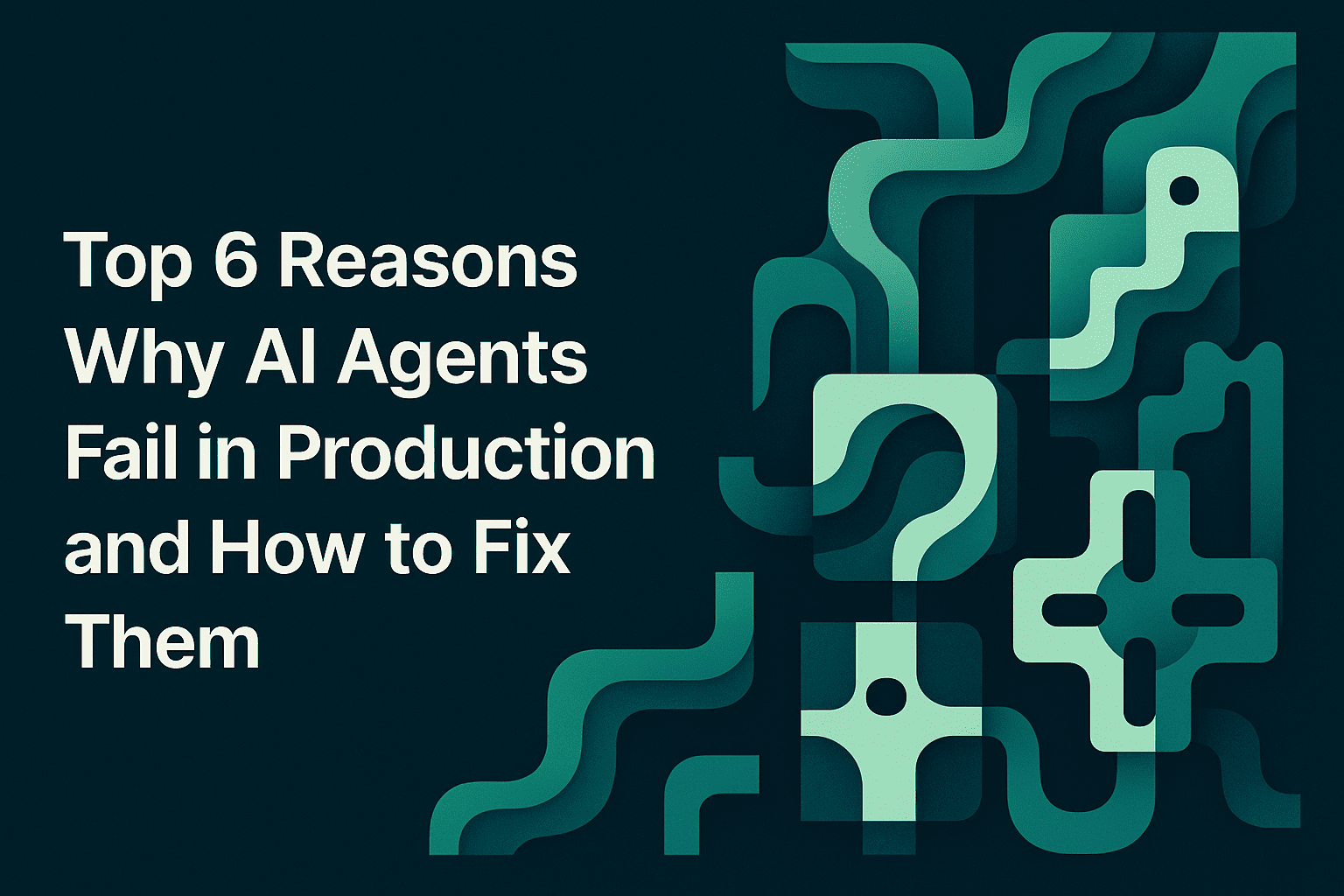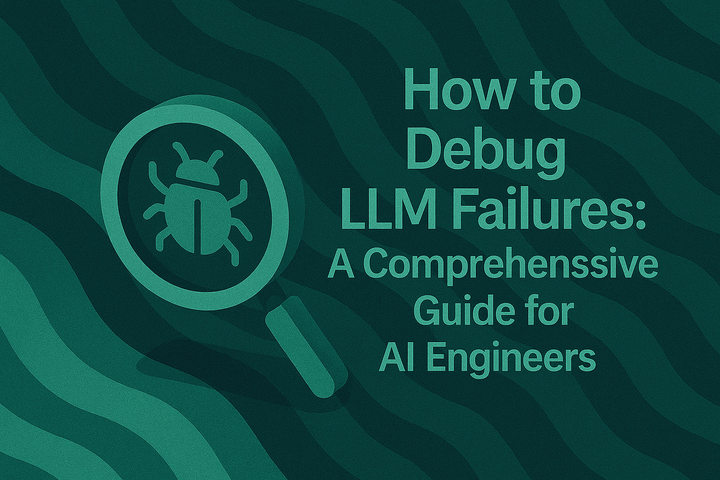Top 6 Reasons Why AI Agents Fail in Production and How to Fix Them

TL;DR
This article explores six primary failure modes: hallucinations, prompt injection vulnerabilities, latency issues from both infrastructure constraints and inefficient agent trajectories, poor tool selection and orchestration, context window limitations causing memory degradation, and distribution shift. While some failures originate from the probabilistic nature of large language models, others stem from system architecture, security design, and integration challenges. We examine the technical mechanisms behind these failures and provide actionable solutions. With proper observability, simulation testing, and continuous monitoring through platforms like Maxim AI, teams can detect anomalies early and maintain reliable AI systems in production.
Introduction
Businesses across industries are rapidly adopting AI agents to automate customer support, streamline internal operations, and enhance user experiences. The transition of AI Agents from development to production often reveals critical vulnerabilities: inconsistent responses, unexpected behaviors, security breaches, and complete system breakdowns that erode user trust and business value.
AI agents built on transformer-based LLMs generate outputs by sampling from a probability distribution over possible tokens. While this introduces some variability, with deterministic sampling methods (temperature=0), many models produce consistent outputs for identical inputs. The unpredictability often stems from high sensitivity to input variations and context dependencies rather than purely stochastic generation.
Understanding why AI agents fail in production requires examining both the technical architecture of these systems and the real-world conditions they encounter. Recognition of these failure patterns and their root causes enables teams to implement preventive measures and monitoring systems that maintain reliability at scale.
This article examines six critical reasons AI agents fail in production and provides evidence-based strategies for addressing each failure mode, helping teams ship more reliable AI applications.
6 Reasons Why AI Agents Fail in Production
1. Hallucination and Non-Deterministic Nature of AI Agents
Large language models powering AI agents operate through probabilistic mechanisms that generate responses by predicting sequences of tokens based on learned probability distributions. During text generation, models sample from these distributions using techniques like temperature-controlled sampling and top-k filtering.
Hallucinations occur when models generate content that appears coherent and plausible but lacks factual grounding. Research measuring hallucination rates shows significant variation across models, tasks, and evaluation methodologies. Recent studies indicate rates ranging from 3% on text summarization tasks to over 90% on specialized tasks like legal citation generation or systematic literature reviews. For instance, Vectara's 2023 benchmarks found GPT-4 hallucinating at 3% on summarization tasks, while Google's PALM 2 showed 27% hallucination rates. Medical systematic review studies found rates of 28-40% for GPT models, and Stanford research on legal queries documented hallucination rates of 69-88%. The variation depends heavily on task complexity, domain specificity, and whether the query requires knowledge outside the model's training distribution.
The technical mechanism involves multiple factors: the model's training objective, which optimizes for linguistic fluency and pattern matching rather than factual accuracy. When the model encounters knowledge gaps, it may produce plausible-sounding text to maintain syntactic and semantic coherence. Hallucinations also arise from the probabilistic decoding in transformer-based LLMs, conflicting or stale training data, issues in fine-tuning datasets, and even explicit instructions in the system prompt, among other factors.
Several factors exacerbate hallucination risks in production environments. Models operating outside their training data distribution face increased uncertainty in their predictions. Complex multi-step reasoning chains amplify these issues, as errors in early reasoning steps propagate through subsequent logical operations.
Solutions and Mitigation Strategies
Retrieval-Augmented Generation (RAG) architectures significantly reduce hallucination by grounding model responses in verified external knowledge. RAG systems retrieve relevant documents from curated knowledge bases before generation, providing factual context that constrains the model's outputs. Implementation requires carefully designed retrieval pipelines that balance precision and recall across diverse query types. However, RAG introduces its own challenges: retrieval quality directly impacts output accuracy, retrieved documents may themselves contain errors, and context overflow can occur when retrieved content exceeds token budgets.
Knowledge base integration extends RAG principles by connecting agents to structured data sources. Agents should be explicitly instructed through system prompts to acknowledge uncertainty when information isn't available rather than generating speculative responses. This approach preserves user trust by establishing clear boundaries around the agent's knowledge.
Implementing hallucination detection evaluators allows teams to identify problematic outputs before they impact end users. Continuous monitoring through observability platforms provides visibility into production behavior patterns and emerging failure modes.
2. Prompt Injection and Security Vulnerabilities
Prompt injection represents a critical security vulnerability where malicious inputs manipulate AI agent behavior to bypass intended constraints. Unlike traditional software vulnerabilities that exploit code flaws, prompt injection exploits the linguistic interface between users and models. Attackers craft inputs that override system instructions, extract confidential information, or trigger harmful outputs.
Research published in security conferences including IEEE Symposium on Security and Privacy and USENIX Security demonstrates that current defenses remain imperfect, with attack success rates varying significantly depending on attack sophistication and defense mechanisms. Even models with safety training remain vulnerable to carefully constructed injection attacks. Attackers use techniques like instruction hijacking, context manipulation, encoded payloads, jailbreaking, multi-turn conditioning, tool-use exploitation, and retrieval poisoning in RAG systems to circumvent security measures.
Production systems face multiple injection vectors. Direct attacks involve users explicitly attempting to manipulate agent behavior through crafted prompts. Indirect attacks embed malicious instructions in documents or data sources that agents retrieve during operation. Multi-turn conversations enable attackers to gradually condition agents toward unintended behaviors across interaction sequences.
Security Implementation Strategies
Architectural separation between system prompts and user inputs provides foundational protection. System prompts containing operational instructions, safety guidelines, and access controls should be clearly delineated from user-controllable content. However, it's important to note that most current LLM APIs process system and user messages in the same context window—"separation" is typically achieved through prompt positioning and explicit instructions rather than true architectural isolation at the infrastructure level.
Implementing strict input validation and sanitization filters potentially malicious content before it reaches the model. Regular expression patterns, keyword filtering, and LLM-based content moderation can identify and neutralize suspicious inputs. However, adversarial attackers continuously develop bypass techniques, requiring continuous security updates.
AI safety metrics provide quantitative measures of security posture. Teams should implement continuous monitoring for prompt injection attempts and anomalous agent behaviors that indicate successful attacks. Establishing baselines for normal operation enables automated detection of deviations that warrant investigation.
Defensive prompt engineering incorporates explicit security instructions within system prompts. Agents should be instructed to reject requests for private information disclosure, refuse harmful content generation, and maintain behavioral boundaries regardless of user coercion attempts. Regular security audits using simulated attacks help identify and patch vulnerabilities before exploitation.
3. Latency and Inefficient Agent Trajectories
Agent trajectory refers to the sequence of actions, tool calls, and reasoning steps an AI agent executes to complete a task. Production latency issues stem from two distinct categories: infrastructure constraints (model inference time, tool execution overhead, and network communication delays) and algorithmic inefficiency where agents perform unnecessary operations, make redundant tool calls, or follow suboptimal reasoning paths.
Technical factors contributing to latency include model inference time, which scales with model size and sequence length. Large language models require significant computational resources. Each tool call introduces additional network round trips and external API latency. Multi-agent systems amplify these delays through coordination overhead and sequential dependencies.
Agent trajectory analysis reveals common inefficiency patterns. Agents may call the same tool multiple times with identical parameters due to poor state management. Unnecessary intermediate reasoning steps consume tokens and inference cycles without advancing toward task completion. Poor planning leads agents to explore unproductive solution paths before backtracking to viable approaches.
Optimization Approaches
Step utility evaluation enables quantitative assessment of each action's contribution toward task completion. By analyzing production trajectories, teams can identify redundant operations and optimize agent behavior. This analysis should examine both successful completions and failed attempts to understand efficiency-outcome relationships.
Trajectory optimization through prompt engineering guides agents toward more efficient execution paths. Instructions can specify preferred reasoning strategies, establish tool usage hierarchies, and encourage minimal-step solutions. Clear success criteria help agents avoid unnecessary verification loops and premature optimization.
Caching strategies reduce redundant computations. Semantic caching stores responses for similar queries based on meaning rather than exact text matching, enabling reuse across semantically equivalent requests. Tool result caching prevents duplicate external API calls within short time windows.
Distributed tracing provides visibility into production agent behavior by capturing complete execution traces including tool calls, reasoning steps, and timing information. Agent observability platforms enable analysis of real-world trajectories at scale, identifying optimization opportunities that testing environments cannot reveal.
4. Tool Selection and Orchestration
AI agents extend language model capabilities by connecting to external tools, APIs, and data sources. Tool selection determines which tools agents invoke to accomplish specific tasks, while orchestration manages the sequencing and coordination of multiple tool calls. Production failures occur when agents select inappropriate tools, misuse tool interfaces, or fail to properly orchestrate complex workflows.
The technical challenge stems from the vast solution space agents navigate when multiple tools could potentially address a task. Models must evaluate tool descriptions, match capabilities to requirements, and predict execution outcomes based on limited context. Ambiguous tool descriptions, overlapping functionality, and insufficient examples all contribute to selection errors.
Orchestration complexity increases exponentially with the number of available tools. Multi-step workflows require agents to maintain state across tool calls, handle errors gracefully, and adapt plans based on intermediate results. Production logs reveal that tool call accuracy can degrade as workflow complexity increases.
Implementation Best Practices
Tool interface design significantly impacts selection accuracy. Comprehensive tool descriptions should specify capabilities, input requirements, output formats, and usage examples. Prompt tools enable standardized tool definition across agent implementations, ensuring consistent behavior.
Evaluation frameworks should measure tool selection quality across diverse scenarios. Testing must cover edge cases, ambiguous requests, and workflows requiring multiple coordinated tool calls. Production monitoring identifies patterns in tool usage and selection errors.
Hierarchical tool organization reduces selection complexity by grouping related capabilities. Agents first select high-level tool categories before choosing specific implementations, narrowing the decision space at each level. This approach mirrors human problem-solving strategies and improves accuracy.
Orchestration frameworks provide structured workflows that guide agent tool usage. While maintaining flexibility for dynamic problem-solving, these frameworks establish guardrails preventing common orchestration errors. Error handling mechanisms ensure graceful degradation when tool calls fail rather than cascading failures.
5. Context Window Limitations and Memory Degradation
Context window constraints represent a fundamental limitation of transformer-based language models. The context window defines the maximum amount of information a model can process simultaneously, typically measured in tokens. Production AI agents handling extended conversations or processing large documents encounter situations where relevant information exceeds available context capacity.
When conversation history exceeds the context window, agents must discard information to accommodate new inputs. Naive truncation strategies remove the earliest conversation turns, potentially eliminating critical context established during initial interactions. This memory degradation manifests as agents forgetting previously stated user preferences, losing track of multi-turn instructions, or contradicting earlier statements.
Research from UC Berkeley demonstrates that model performance degrades significantly when relevant information appears near context window boundaries, a phenomenon called "lost in the middle" effect. Models exhibit recency bias, prioritizing recently processed information over content from earlier in the context. This bias compounds memory degradation effects in long conversations.
Memory Management Strategies
Intelligent context compression techniques preserve essential information while reducing token consumption. Summarization models condense conversation history into compact representations retaining key facts, decisions, and user preferences. Dynamic compression adjusts detail levels based on information relevance and recency.
Hierarchical memory architectures separate short-term working memory from long-term knowledge storage. Agents maintain recent conversation context in the immediate context window while storing historical information in external databases. Session management systems track user interactions across extended timescales, enabling retrieval of relevant historical context when needed.
Retrieval-augmented memory systems query external knowledge bases to access information beyond the immediate context window. When agents encounter references to previous interactions, they retrieve relevant conversation segments rather than maintaining everything in context. This approach scales to arbitrarily long interaction histories.
Context window expansion through model selection provides a direct solution when available. Recent model releases offer significantly larger context windows, with some models supporting over 100,000 tokens. However, teams must balance context capacity against increased latency and computational costs associated with processing larger contexts.
6. Distribution Shift and Overfitting
Distribution shift occurs when production data diverges from the distribution of data used during model training or fine-tuning. AI agents optimized on specific datasets may perform excellently in testing but fail when encountering production scenarios that differ from training conditions. This failure mode particularly affects specialized LLMs fine-tuned for specific domains or use cases.
Overfitting manifests when models memorize training patterns rather than learning generalizable capabilities. While achieving high accuracy on test sets, overfitted models perform poorly on variations not represented in training data. Production environments introduce natural variation in user language, query patterns, and contextual factors that expose overfitting vulnerabilities.
Temporal drift represents a gradual form of distribution shift where user behavior, language patterns, or domain knowledge evolves over time. An agent deployed in January may encounter different query distributions in June as users adapt their interaction patterns or as external events change common information needs. Without continuous monitoring, performance degradation from temporal drift goes undetected until user complaints emerge.
Mitigation and Monitoring Approaches
Diverse training and evaluation datasets reduce overfitting risks by exposing models to broader pattern variations during development. Dataset curation should systematically include edge cases, minority patterns, and potential future scenarios beyond typical usage patterns.
Continuous evaluation on production data enables early detection of distribution shift. Teams should establish baseline performance metrics on representative production samples and monitor for degradation over time. Online evaluations provide real-time quality assessment as production conditions evolve.
Regular model updates and retraining incorporate new production patterns into model knowledge. Data collection pipelines should capture representative production samples for inclusion in training datasets. This feedback loop helps models adapt to evolving distributions while maintaining performance on historical patterns.
Simulation testing across diverse scenarios and user personas reveals overfitting before production deployment. Stress testing with edge cases, unusual query patterns, and adversarial examples exposes brittleness that standard evaluation misses. Comprehensive simulation coverage provides confidence in robust generalization.
How Maxim Helps
Maxim AI provides an end-to-end platform addressing the production failure modes discussed above through comprehensive simulation, evaluation, and observability capabilities designed specifically for AI agents.
Advanced Anomaly and Hallucination Detection
Maxim's pre-built evaluators include specialized metrics for detecting hallucinations and factual inconsistencies. The faithfulness evaluator measures whether agent responses remain grounded in provided context, while consistency evaluators identify contradictions across responses. Teams can configure these evaluators to run automatically on production logs, enabling early detection of problematic outputs.
Real-Time Observability and Distributed Tracing
The observability platform provides complete visibility into production agent behavior through distributed tracing. Teams can track every step of agent execution including tool calls, reasoning chains, and external API interactions. This granular visibility enables rapid root cause analysis when failures occur. Custom dashboards allow teams to monitor key metrics across dimensions relevant to their specific applications.
Simulation for Stress Testing
Agent simulation capabilities enable teams to test agents across hundreds of scenarios and user personas before production deployment. Simulations can stress test edge cases, adversarial inputs, and unusual interaction patterns that might not appear in initial testing. Teams can analyze agent trajectories to identify inefficiencies and optimize behavior before they impact real users.
Security and Safety Monitoring
Maxim includes evaluators specifically designed for security assessment. PII detection identifies potential data leakage, while toxicity evaluation monitors for harmful outputs. Teams can establish alerts and notifications that trigger when security metrics exceed acceptable thresholds, enabling immediate response to potential breaches.
Comprehensive Evaluation Framework
The platform supports both offline evaluations during development and online evaluations in production. Task success evaluation measures whether agents accomplish intended objectives, while tool selection evaluators assess orchestration quality. Teams can create custom evaluators tailored to application-specific requirements.
Prompt Management and Experimentation
Prompt versioning and deployment capabilities enable systematic experimentation and rollback when issues arise. The prompt playground facilitates rapid iteration on prompt designs with immediate evaluation feedback. Teams can compare prompt performance across quality, cost, and latency metrics before production deployment.
Conclusion
Production failures of AI agents stem from fundamental characteristics of large language models combined with system architecture and integration challenges. The six failure modes examined—hallucinations, security vulnerabilities, latency issues, tool selection errors, memory degradation, and distribution shift—represent predictable consequences of deploying complex AI systems in real-world environments.
Success in production requires recognizing that these failure modes cannot be completely eliminated, only managed through systematic monitoring, evaluation, and rapid remediation. Teams must implement comprehensive observability to detect issues early, conduct thorough pre-deployment testing including adversarial scenarios, and maintain continuous evaluation pipelines that track quality as conditions evolve.
The transition from viewing AI agents as deterministic software to understanding them as systems requiring probabilistic quality control represents a fundamental shift in development practices. Organizations that adopt appropriate tooling, establish rigorous evaluation frameworks, and maintain vigilant production monitoring will achieve reliable AI systems that deliver sustained business value.
Get started with Maxim AI to implement comprehensive evaluation and observability for your AI agents, or schedule a demo to see how leading teams are shipping reliable AI applications 5x faster.


